The Radeon R9 280X Review: Feat. Asus & XFX - Meet The Radeon 200 Series
by Ryan Smith on October 8, 2013 12:01 AM ESTCompute
Jumping into compute, as with our synthetic benchmarks we aren’t expecting too much new here. Outside of DirectCompute GK104 is generally a poor compute GPU, which makes everything very easy for the Tahiti based 280X. At the same time compute is still a secondary function for these products, so while important the price cuts that go with the 280X are not quite as meaningful here.
As always we'll start with our DirectCompute game example, Civilization V, which uses DirectCompute to decompress textures on the fly. Civ V includes a sub-benchmark that exclusively tests the speed of their texture decompression algorithm by repeatedly decompressing the textures required for one of the game’s leader scenes. While DirectCompute is used in many games, this is one of the only games with a benchmark that can isolate the use of DirectCompute and its resulting performance.
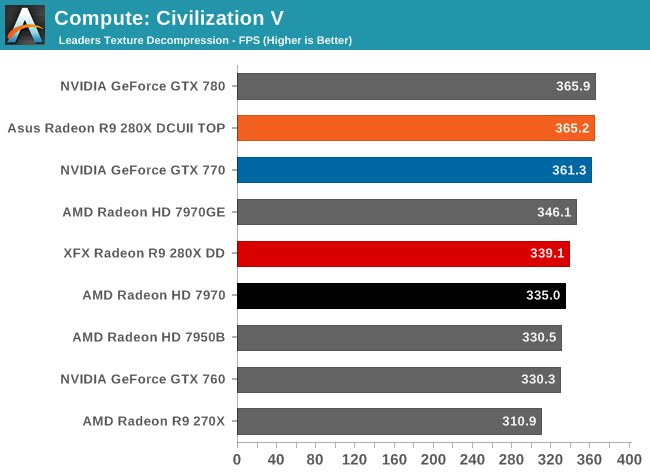
With Civilization V we’re finding that virtually every high-end GPU is running into the same bottleneck. We’ve reached the point where even GPU texture compression is CPU-bound.
Our next benchmark is LuxMark2.0, the official benchmark of SmallLuxGPU 2.0. SmallLuxGPU is an OpenCL accelerated ray tracer that is part of the larger LuxRender suite. Ray tracing has become a stronghold for GPUs in recent years as ray tracing maps well to GPU pipelines, allowing artists to render scenes much more quickly than with CPUs alone.
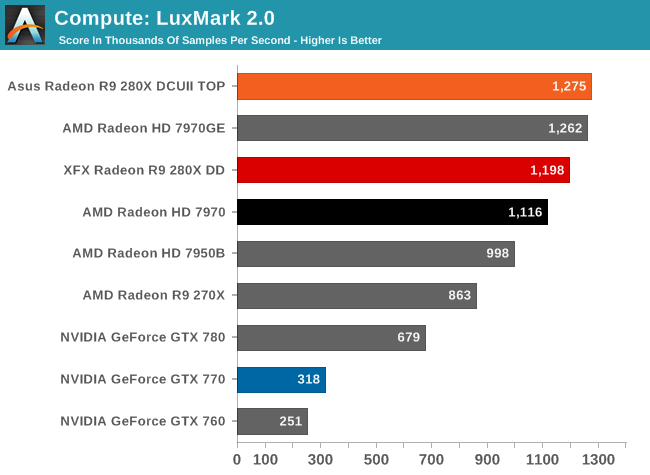
AMD simply rules the roost when it comes to LuxMark, so the only thing close to 280X here are other Tahiti parts.
Our 3rd compute benchmark is Sony Vegas Pro 12, an OpenGL and OpenCL video editing and authoring package. Vegas can use GPUs in a few different ways, the primary uses being to accelerate the video effects and compositing process itself, and in the video encoding step. With video encoding being increasingly offloaded to dedicated DSPs these days we’re focusing on the editing and compositing process, rendering to a low CPU overhead format (XDCAM EX). This specific test comes from Sony, and measures how long it takes to render a video.
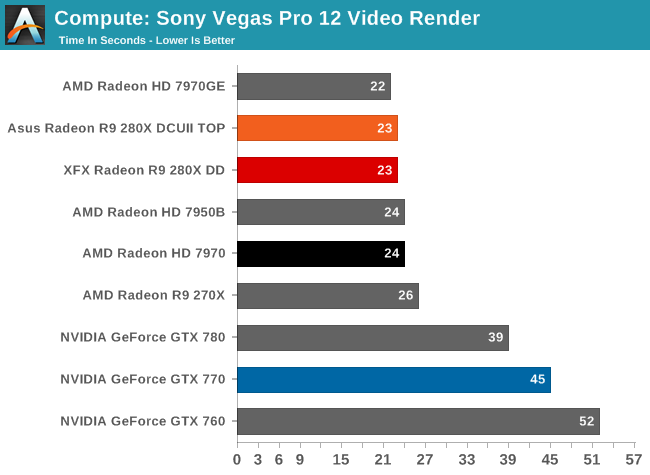
Again AMD’s strong compute performance shines through, with 280X easily topping the chart.
Our 4th benchmark set comes from CLBenchmark 1.1. CLBenchmark contains a number of subtests; we’re focusing on the most practical of them, the computer vision test and the fluid simulation test. The former being a useful proxy for computer imaging tasks where systems are required to parse images and identify features (e.g. humans), while fluid simulations are common in professional graphics work and games alike.
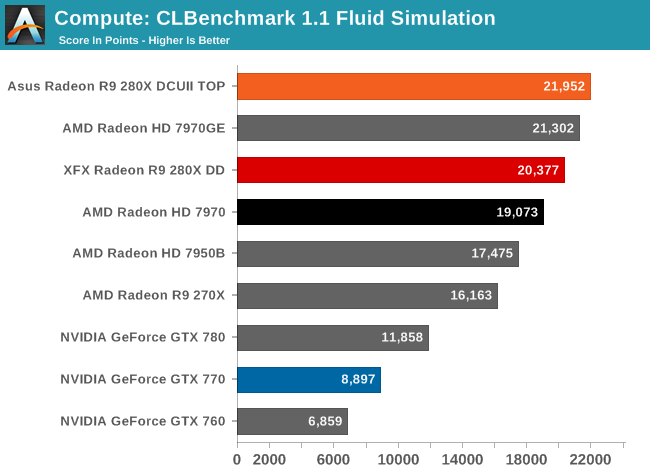
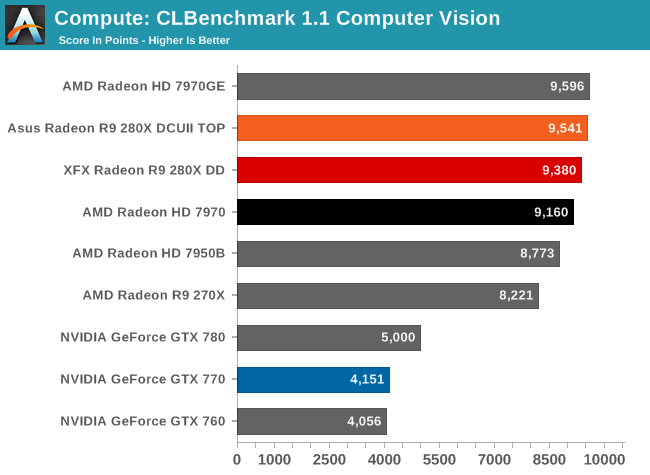
Despite the significant differences in these two workloads, in both cases 280X comes out easily on top.
Moving on, our 5th compute benchmark is FAHBench, the official Folding @ Home benchmark. Folding @ Home is the popular Stanford-backed research and distributed computing initiative that has work distributed to millions of volunteer computers over the internet, each of which is responsible for a tiny slice of a protein folding simulation. FAHBench can test both single precision and double precision floating point performance, with single precision being the most useful metric for most consumer cards due to their low double precision performance. Each precision has two modes, explicit and implicit, the difference being whether water atoms are included in the simulation, which adds quite a bit of work and overhead. This is another OpenCL test, as Folding @ Home has moved exclusively to OpenCL this year with FAHCore 17.

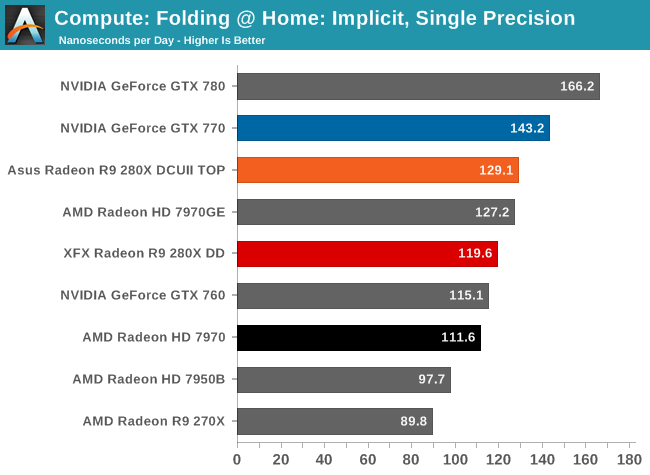

Depending on the mode and the precision, we can have wildly different results. The 280X does well in FP32 explicit, for example, but in implicit mode the 280X is now caught between the GTX 770 and GTX 760. But if we move to double precision then AMD’s native ¼ FP64 execution speed gives them a significant advantage here.
Wrapping things up, our final compute benchmark is an in-house project developed by our very own Dr. Ian Cutress. SystemCompute is our first C++ AMP benchmark, utilizing Microsoft’s simple C++ extensions to allow the easy use of GPU computing in C++ programs. SystemCompute in turn is a collection of benchmarks for several different fundamental compute algorithms, as described in this previous article, with the final score represented in points. DirectCompute is the compute backend for C++ AMP on Windows, so this forms our other DirectCompute test.
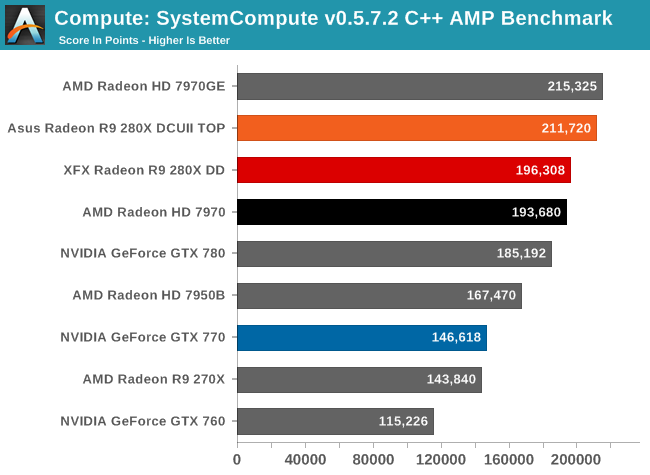
Although not by any means a blowout, yet again the 280X vies for the top here. When it comes to compute, the Tahiti based 280X is generally unopposed by anything in its price range.










151 Comments
View All Comments
Ryan Smith - Tuesday, October 8, 2013 - link
That's the first I've seen of that, so I can't really comment.But when I was discussing Mantle with AMD, they did discount using OpenGL. There was a specific desire to have a pure API that was completely free from legacy cruft (and there's nothing cruftier than OGL) while also being free to quickly evolve the project without having to involve the ARB.
konondrum - Tuesday, October 8, 2013 - link
Well this is one of the most disappointing products launches I've ever seen. At least the nVidia 700 series was more then a sticker change. This isn't even really a price drop as $300 7970s and $200 7870s (with game bundles) have been available for a while. Tell me AMD, why am I supposed to care? If these included TrueAudio at least that would be a differentiating feature, but there is seriously nothing new here at all.The only good thing I can say about this is that it makes me much more comfortable about my current 660ti 3gb. Looks like it will be strong though 2014 at least.
just4U - Tuesday, October 8, 2013 - link
I've yet to see a 7970 GHZ Ed. for under $360.. Hell until a month and a half ago you were lucky to get it under $400 on sale.just4U - Tuesday, October 8, 2013 - link
At any rate this may put some pressure on Nvidia for their 7x series.. I think it's going to be incentive for those still rocking it out on Amd's 6000 series or Nvidia 500 series and earlier to maybe upgrade.Personally I figure if you got a 570/80 or a 6950 (or better) the new stuff by both companies is a bit of a hard sell unless your playing at crazy resolutions... most still sit comfortably in 1080P or 1920/1200 resolution and the old standby 1600/1050.
matagyula - Tuesday, October 8, 2013 - link
I have been looking to replace my now 2 year old HD6870 with something a little beefier, and I was eagerly awaiting AMDs new product launch.But now I am left with even more questions than before - most importantly, should I upgade at all in the upcoming 8-12 months? The card is still putting in solid work, and while I have to settle for mid-high detail settings when it comes to titles like BF3 or Crysis 3, other games perform just fine /DotA 2 and CS:GO @ 1920*1200/.
At the 170-200eur price range I am looking at HD7870, or waiting a couple months for the HD7950 to drop bellow 200eur, while the HD7970 is still at 330eur in Slovakia.
The more I think about it the more I am inclined towards holding off for another year or so :|
ShieTar - Tuesday, October 8, 2013 - link
Stop buying locally. You can order a 7970 for ~240€ from Germany, and delivery to Slovakia should not cost more than ~15€ :http://www.heise.de/preisvergleich/eu/?cat=gra16_5...
Of course an Austrian or Polish shop may be even cheaper for some cards, if the postage is less than for a delivery from Germany. Or depending on where you live, maybe you just go and have a daytrip into either country and bring the card back home ;-)
just4U - Tuesday, October 8, 2013 - link
Well Matt, I sold my 6950 2G and really wanted a 670 or a 7950-70 as I figured that was a decent upgrade. I settled for the 7870 and noticed some ok gains. It's a tough call for you though..The 280X is going to give you 7970GHZ Ed like performance according to reviews.. but basically in the price range of a 7870. Tempting.. but you might get lucky with close out deals on the 7970 or even see price drops on the 770 from Nvidia. that are more attractive. All worthwhile upgrades over the 6870 but not night/day differences.. We really haven't seen a chip come out yet that raises the bar to a whole new level.
piroroadkill - Tuesday, October 8, 2013 - link
Wow. This is a boring card launch.The ASUS card itself is a good SKU, but absolutely nothing that could not have been done branded as 7970.
I understand they have a lot of old GPUs they want to re-use, so they don't want to re-tool them for the TrueAudio DSP, but it is downright stupid that they didn't at least add another small package to the card with the DSP in, so the new range can have feature parity.
AMD, your new card names are terrible, and this launch is pretty bland and watered down.
ninjaquick - Tuesday, October 8, 2013 - link
Well, that is inevitable. AMD's GCN design is not top-down, it is fully modular. IMC / ROP / ShaderClusters are all their own modules, each 'TMU' is attached to 16 'compute cores'. The entire point of the GCN design is that it scales up infinitely. This is why AMD is releasing Mantle. There is no reason to abandon the GCN design in the near future.It is not like AMD is releasing a brand new never seen before design that is the culmination of years of design work. The 290X is literally a 7970 with 12 more ROPs and an extra 128bit memory path which are only needed to accomodate the extra 48 rendering clusters. If you were to take the 7970 and add 48 clusters at the same clock speed you would get *exactly* the same perf as what the 290X delivers. Simple as that.
thylboy - Tuesday, October 8, 2013 - link
I saw on AMD´s homepage that these cards support their "Zero Core" technology. Can anyone confirm whether cards like this actually turn off the fans completely when in the long idle mode or not?